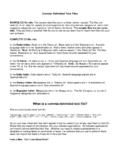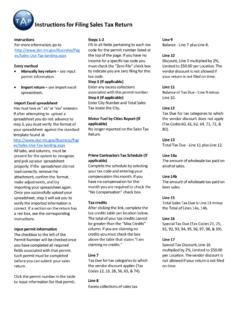Transcription of Logix5000 Controllers Add On Instructions …
1 Programming Manual Logix 5000 Controllers Add On Instructions 1756 ControlLogix, 1756 GuardLogix, 1769 CompactLogix, 1769 Compact GuardLogix, 1789 SoftLogix, 5069 CompactLogix, 5069 Compact GuardLogix, Studio 5000 Logix Emulate Important user information Read this document and the documents listed in the additional resources section about installation, configuration, and operation of this equipment before you install, configure, operate, or maintain this product. Users are required to familiarize themselves with installation and wiring Instructions in addition to requirements of all applicable codes, laws, and standards. Activities including installation, adjustments, putting into service, use, assembly, disassembly, and maintenance are required to be carried out by suitably trained personnel in accordance with applicable code of practice.
2 If this equipment is used in a manner not specified by the manufacturer, the protection provided by the equipment may be impaired. In no event will Rockwell Automation, Inc. be responsible or liable for indirect or consequential damages resulting from the use or application of this equipment. The examples and diagrams in this manual are included solely for illustrative purposes. Because of the many variables and requirements associated with any particular installation, Rockwell Automation, Inc. cannot assume responsibility or liability for actual use based on the examples and diagrams. No patent liability is assumed by Rockwell Automation, Inc. with respect to use of information, circuits, equipment, or software described in this manual.
3 Reproduction of the contents of this manual, in whole or in part, without written permission of Rockwell Automation, Inc., is prohibited. Throughout this manual, when necessary, we use notes to make you aware of safety considerations. WARNING: Identifies information about practices or circumstances that can cause an explosion in a hazardous environment, which may lead to personal injury or death, property damage, or economic loss. ATTENTION: Identifies information about practices or circumstances that can lead to personal injury or death, property damage, or economic loss. Attentions help you identify a hazard, avoid a hazard, and recognize the consequence Important: Identifies information that is critical for successful application and understanding of the product.
4 Labels may also be on or inside the equipment to provide specific precautions. SHOCK HAZARD: Labels may be on or inside the equipment, for example, a drive or motor, to alert people that dangerous voltage may be present. BURN HAZARD: Labels may be on or inside the equipment, for example, a drive or motor, to alert people that surfaces may reach dangerous temperatures. ARC FLASH HAZARD: Labels may be on or inside the equipment, for example, a motor control center, to alert people to potential Arc Flash. Arc Flash will cause severe injury or death. Wear proper Personal Protective Equipment (PPE). Follow ALL Regulatory requirements for safe work practices and for Personal Protective Equipment (PPE).
5 Allen-Bradley, Rockwell Software, Rockwell Automation, and TechConnect are trademarks of Rockwell Automation, Inc. Trademarks not belonging to Rockwell Automation are property of their respective companies. Rockwell Automation Publication 1756-PM010I-EN-P - February 2018 3 Summary of changes This manual includes new and updated information. Use these reference tables to locate changed information. Grammatical and editorial style changes are not included in this summary. Global changes This table identifies changes that apply to all information about a subject in the manual and the reason for the change. For example, the addition of new supported hardware, a software design change, or additional reference material would result in changes to all of the topics that deal with that subject.
6 Subject Reason Updated supported Controllers . Logix Designer supports new Controllers . Updated screen shots. The Logix Designer interface has been updated. New or enhanced features This table contains a list of topics changed in this version, the reason for the change, and a link to the topic that contains the changed information. Topic Name Reason Create an alarm definition on page 67 Added information about tag-based alarms and alarm definitions. Rockwell Automation Publication 1756-PM010I-EN-P - February 2018 5 Table of contents Studio 5000 environment .. 9 Additional resources .. 9 Understanding terminology .. 10 Legal notices .. 11 Chapter 1 Introduction.
7 15 About Add-On Instructions .. 15 Components of an Add-On Instruction .. 16 General information .. 16 Parameters .. 19 Local tags .. 19 Data Type .. 20 Logic routine .. 21 Optional Scan Modes routines .. 22 Instruction signature .. 23 Signature history .. 23 Change History .. 24 Help .. 24 Considerations for Add-On Instructions .. 25 Instruction functionality .. 25 Encapsulation .. 25 Safety Add-On Instructions .. 25 Instruction signature .. 26 Safety instruction signature .. 27 Programming languages .. 27 Transitional Instructions .. 28 Instruction size .. 28 Runtime editing .. 29 Nesting Add-On Instructions .. 29 Routines versus Add-On 29 Programmatic access to data.
8 30 Unavailable Instructions within Add-On Instructions .. 31 Use GSV and SSV Instructions .. 31 Considerations when creating parameters .. 33 Passing arguments to parameters by reference or by value .. 33 Selecting a data type for a parameter .. 33 Creating an alias parameter for a local tag .. 34 Using a single dimension array as an InOut parameter .. 34 Determining which parameters to make visible or required .. 34 Using standard and safety tags .. 36 Data access control .. 36 Constant values .. 37 External Access .. 37 Planning your Add-On Instruction design .. 38 Intended behavior .. 38 Preface Designing Add-On Instructions Table of contents 6 Rockwell Automation Publication 1756-PM010I-EN-P - February 2018 Parameters.
9 38 Naming conventions .. 39 Source 39 Nesting - reuse Instructions .. 39 Local tags .. 39 Programming languages .. 39 Scan mode routines .. 39 Test .. 40 Help documentation .. 40 Chapter 2 Creating an Add-On Instruction .. 41 Creating a parameter .. 42 Creating a module reference parameter .. 44 Creating local tags .. 46 Editing parameters and local tags .. 48 Updates to arguments following parameter edits .. 48 Copying parameter or local tag default values .. 49 Creating logic for the Add-On instruction .. 51 Execution considerations for Add-On Instructions .. 52 Optimizing performance .. 52 Defining operation in different scan modes .. 52 Enabling scan modes.
10 54 Prescan routine .. 54 Postscan 56 EnableInFalse routine .. 57 Using the EnableIn and EnableOut parameters .. 59 EnableIn parameter and ladder diagrams .. 59 EnableIn parameter and function blocks .. 59 EnableIn parameter and structured text .. 60 Changing the class of an Add-On Instruction .. 60 Testing the Add-On Instruction .. 61 Before you test .. 61 Testing the flow .. 61 Monitoring logic with data context views .. 61 Verifying individual scan modes .. 62 Defining source protection for an Add-On Instruction .. 63 Enable the source protection feature .. 64 Generating an Add-On Instruction signature .. 64 Generating, removing, or copying an instruction signature.













